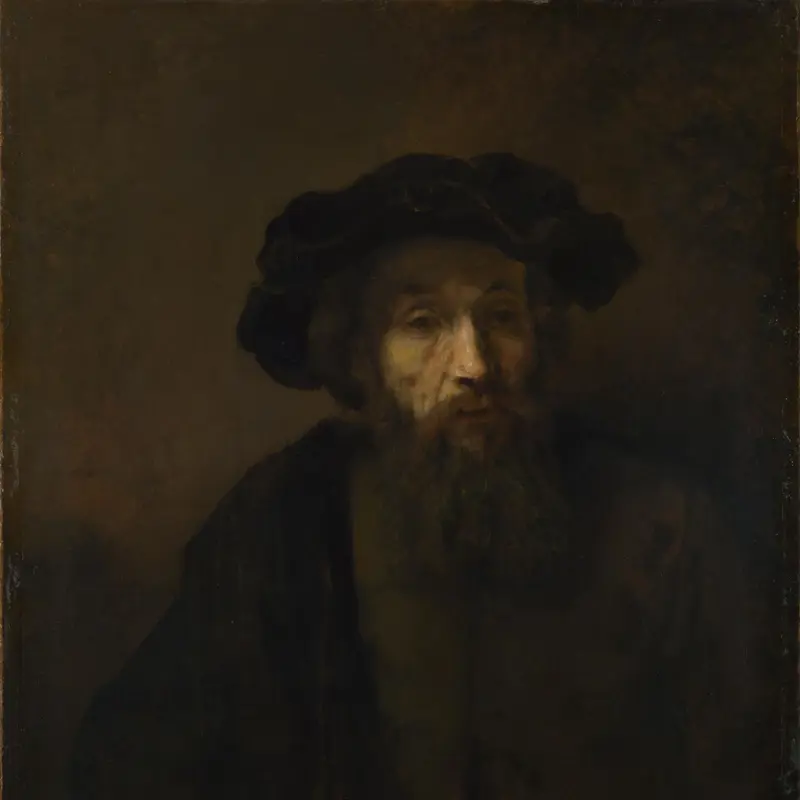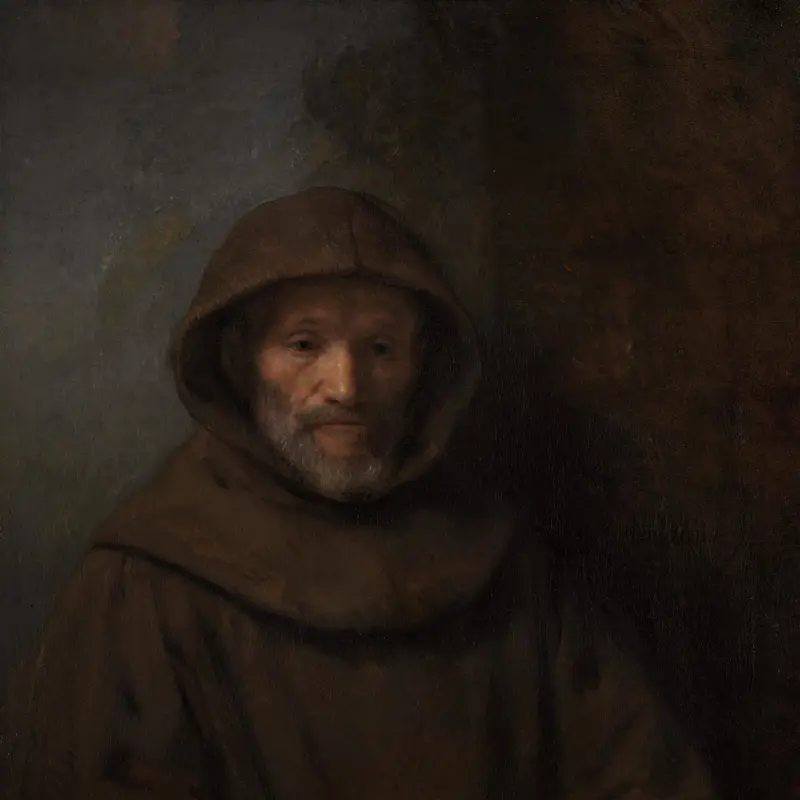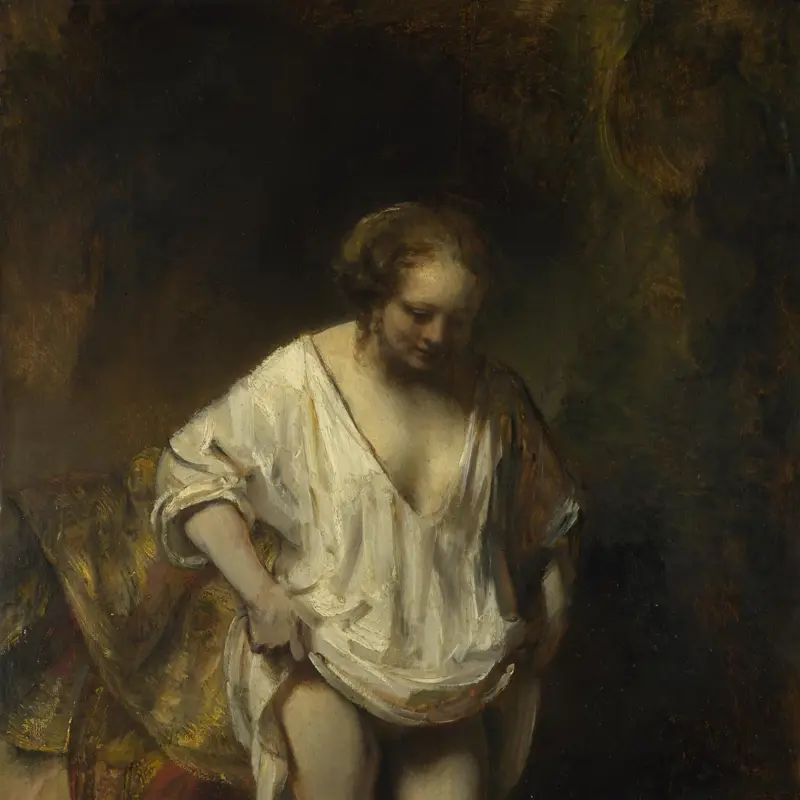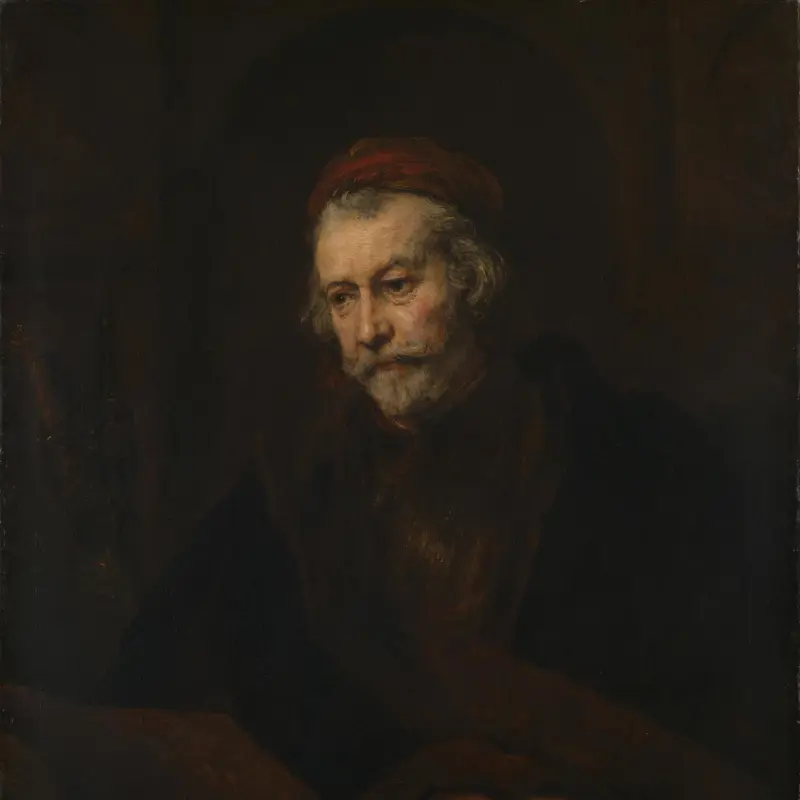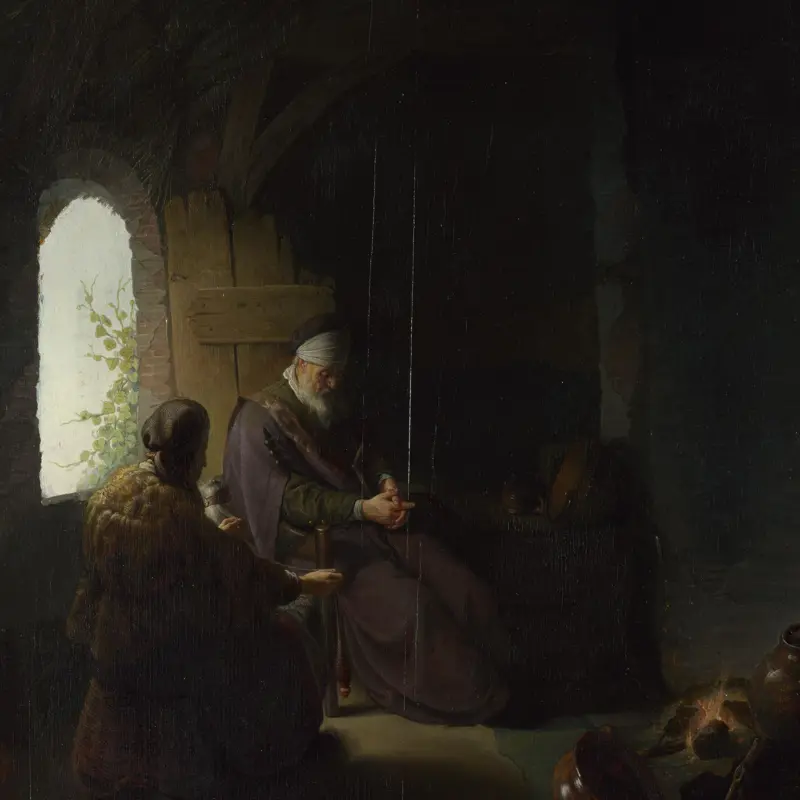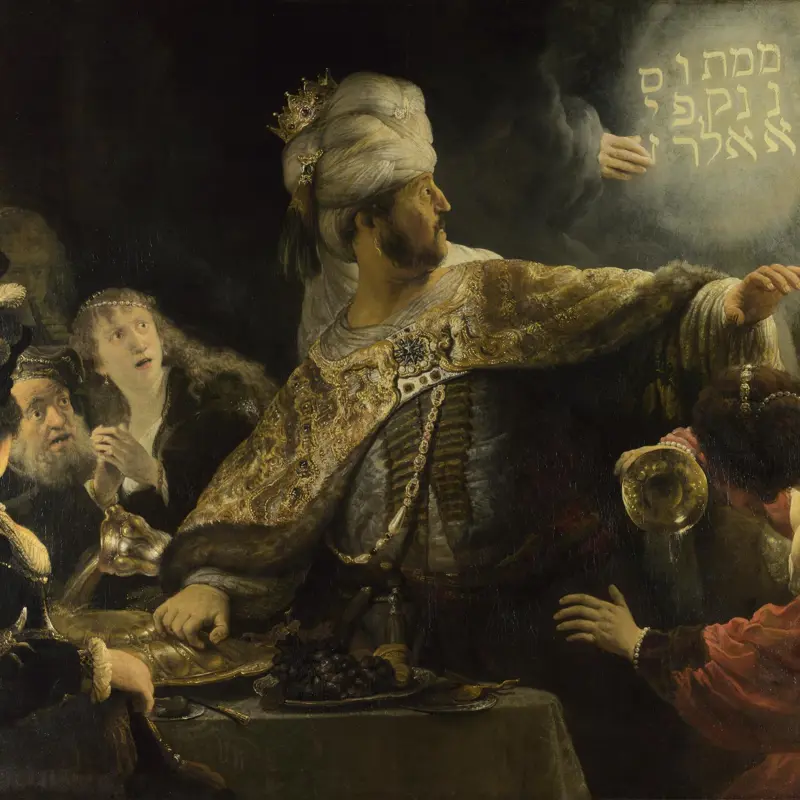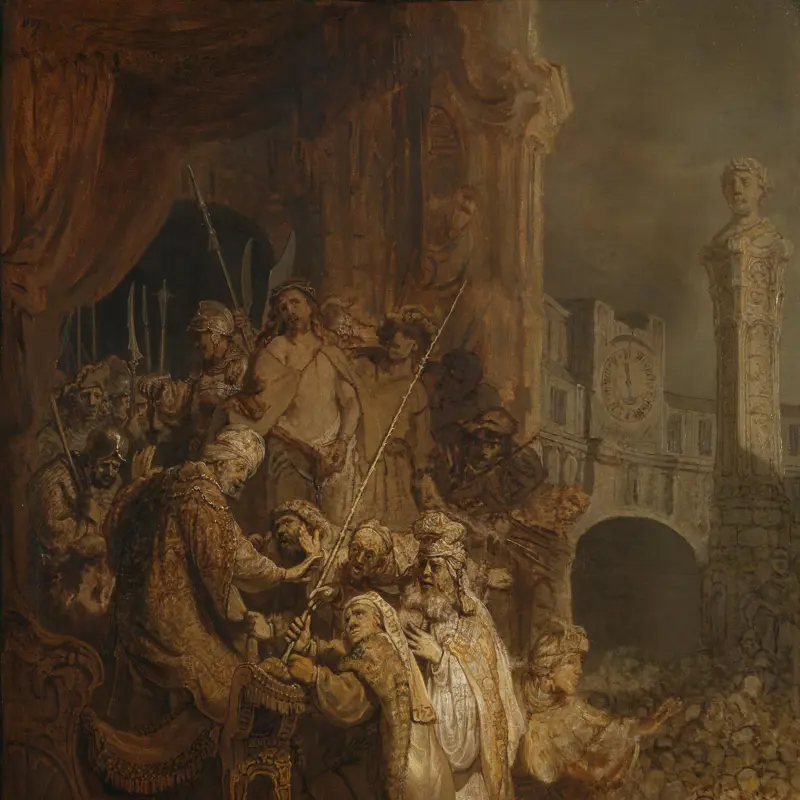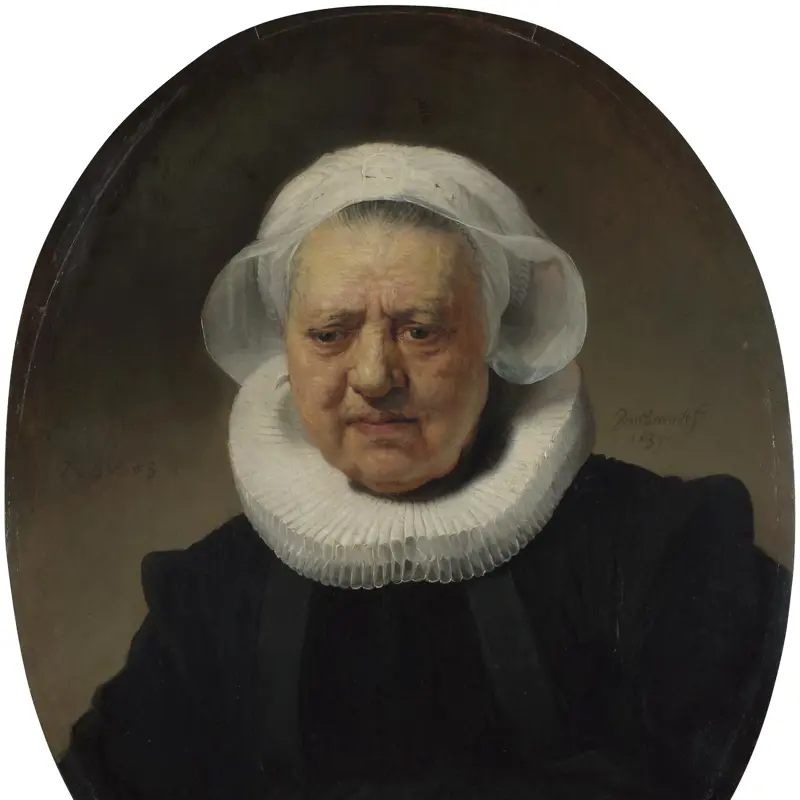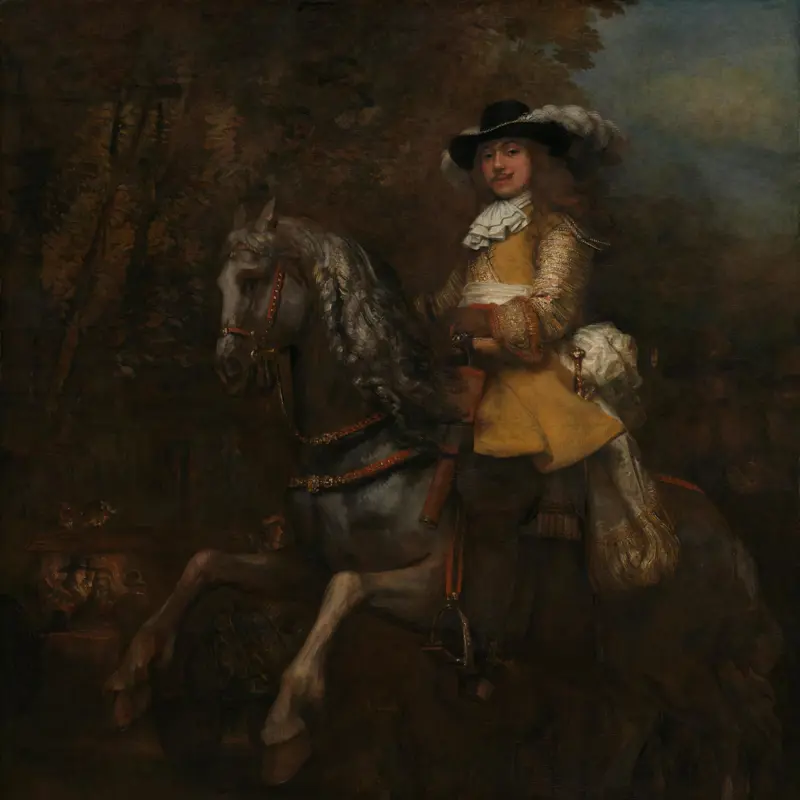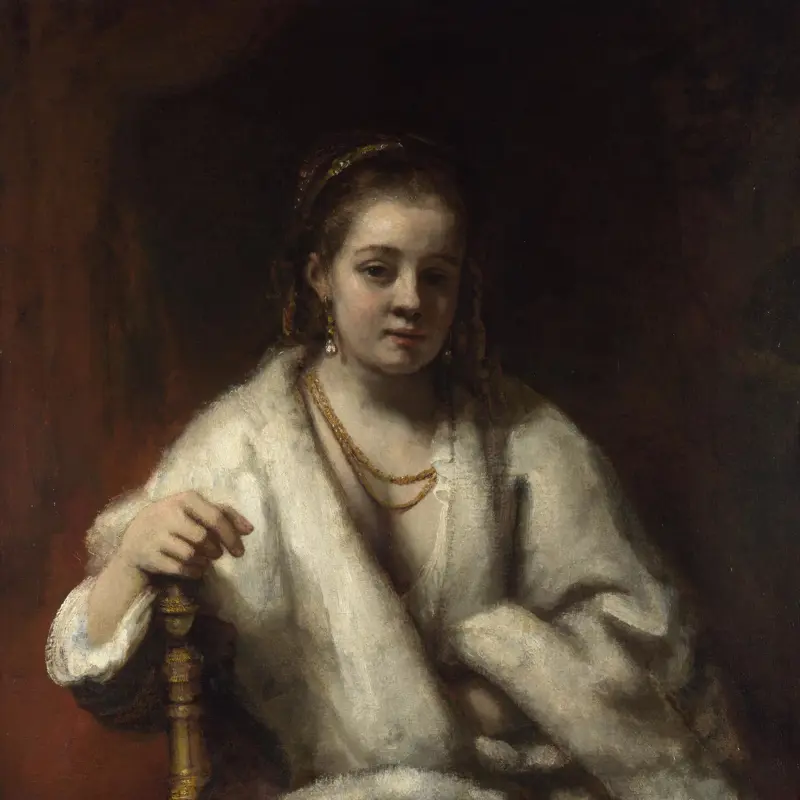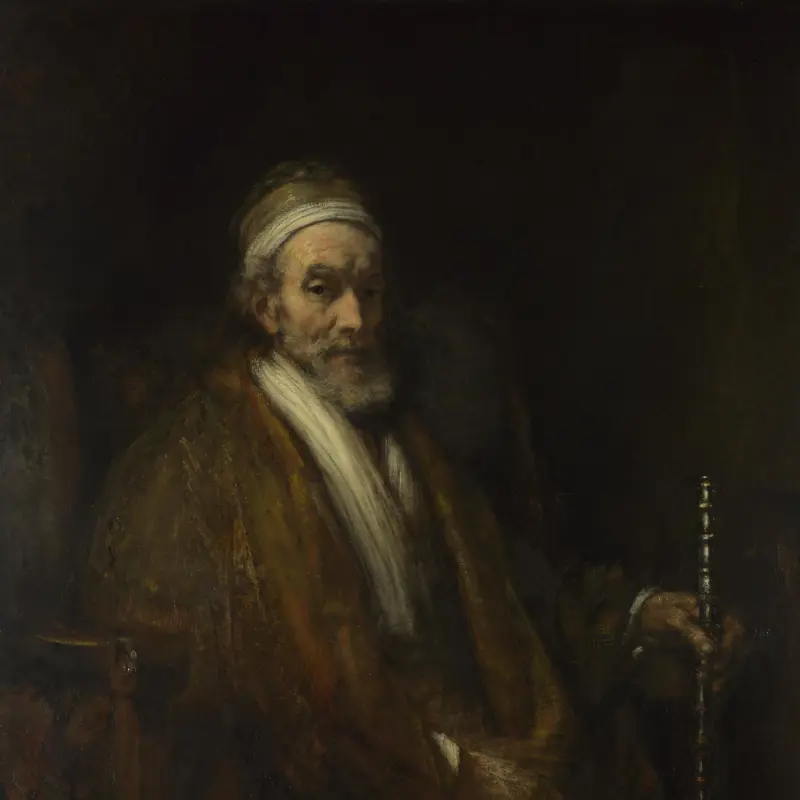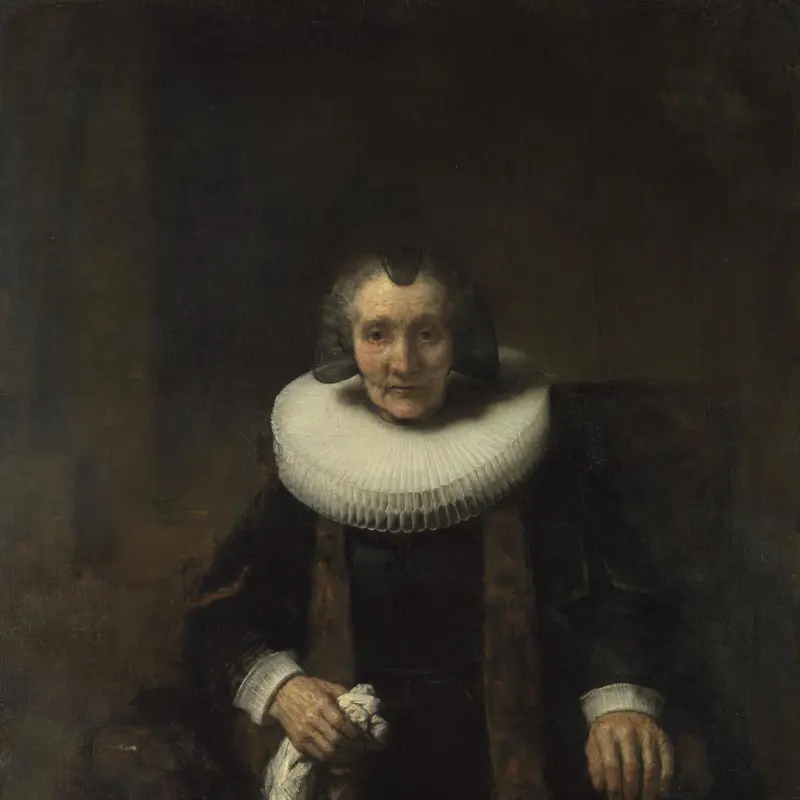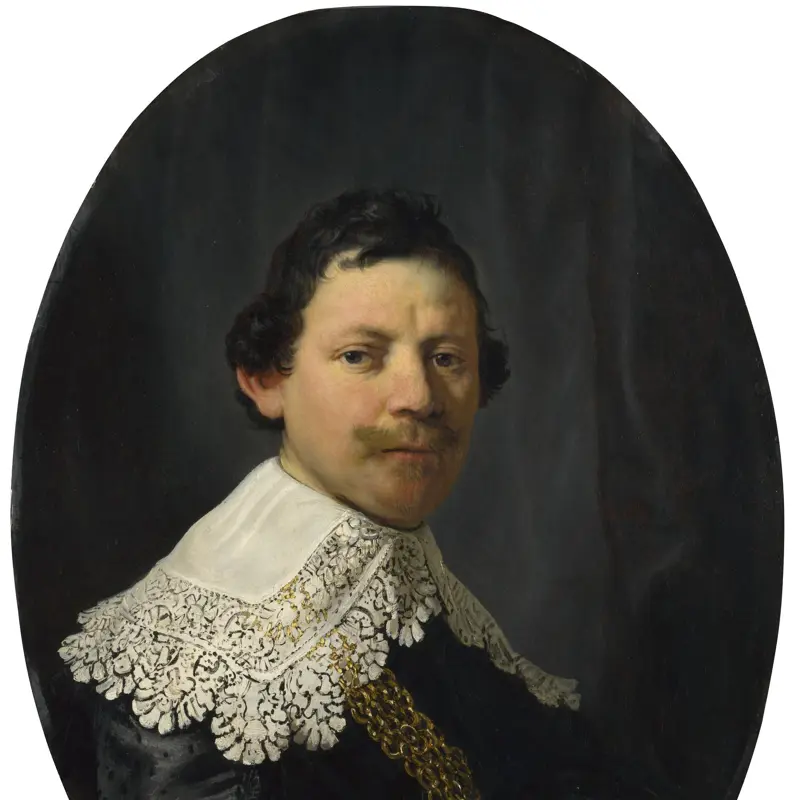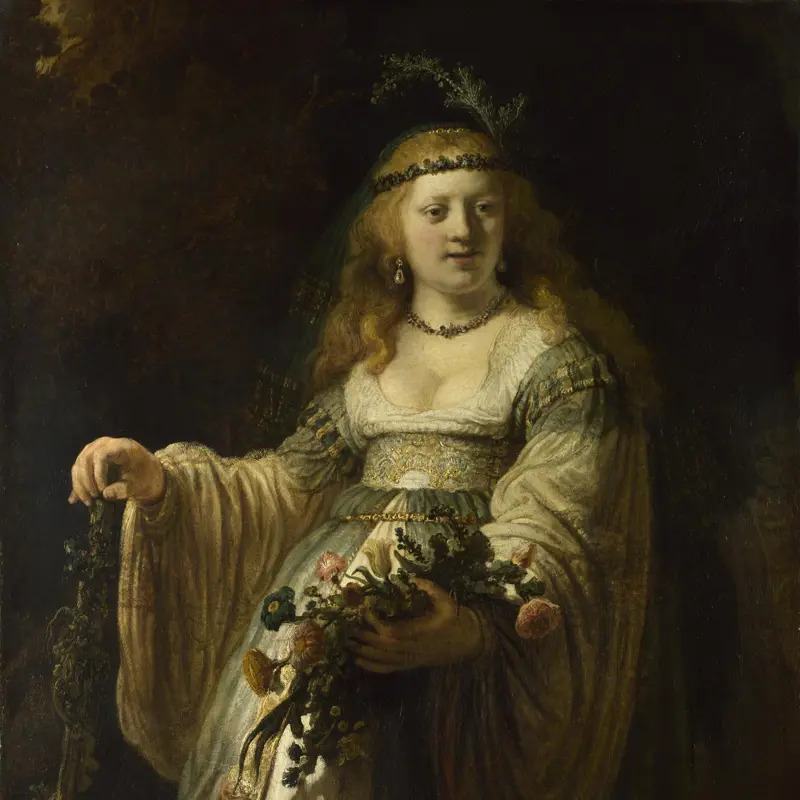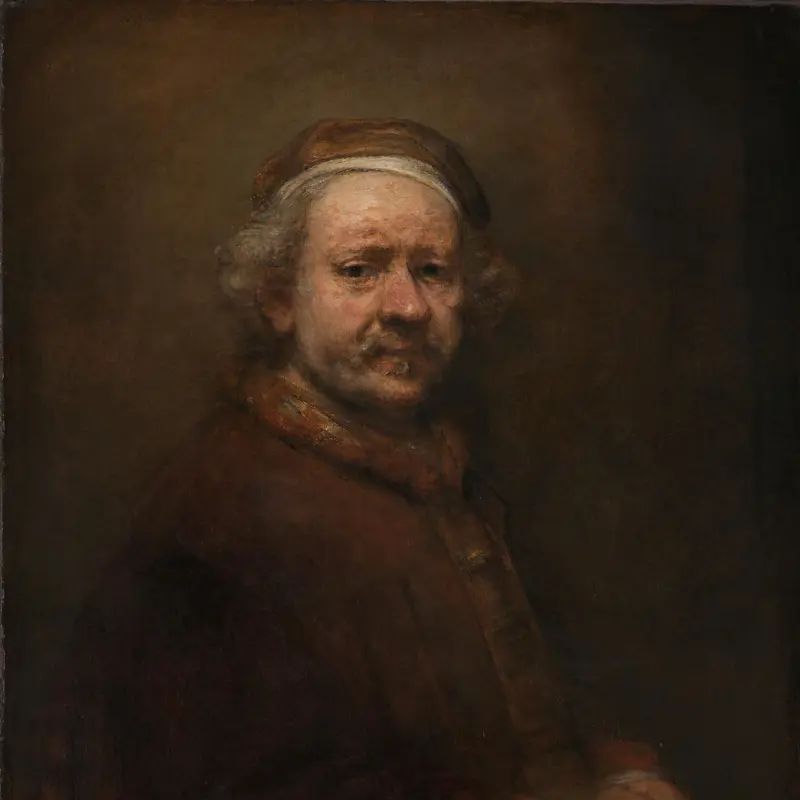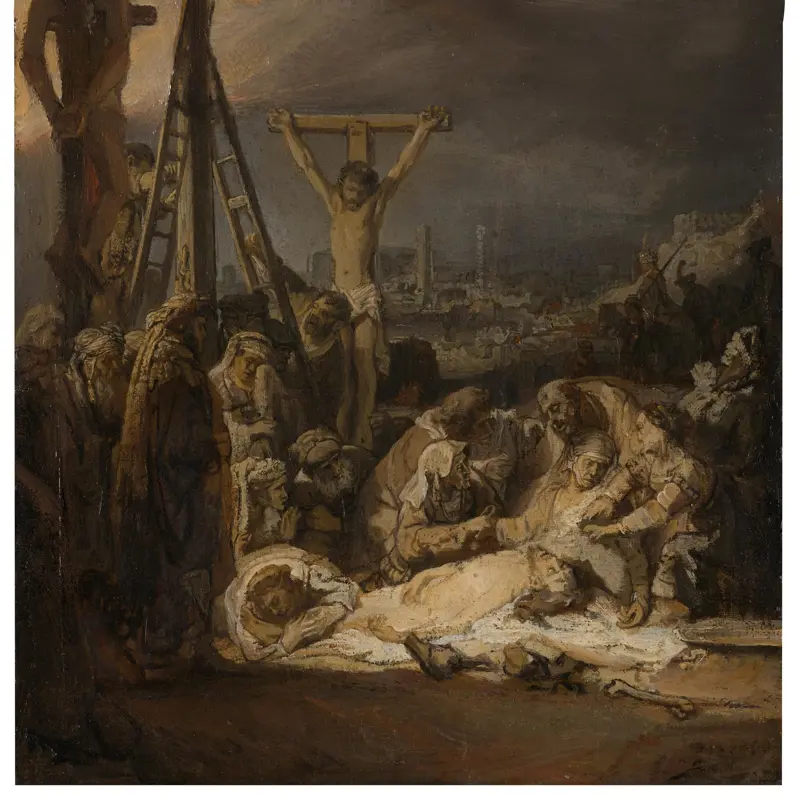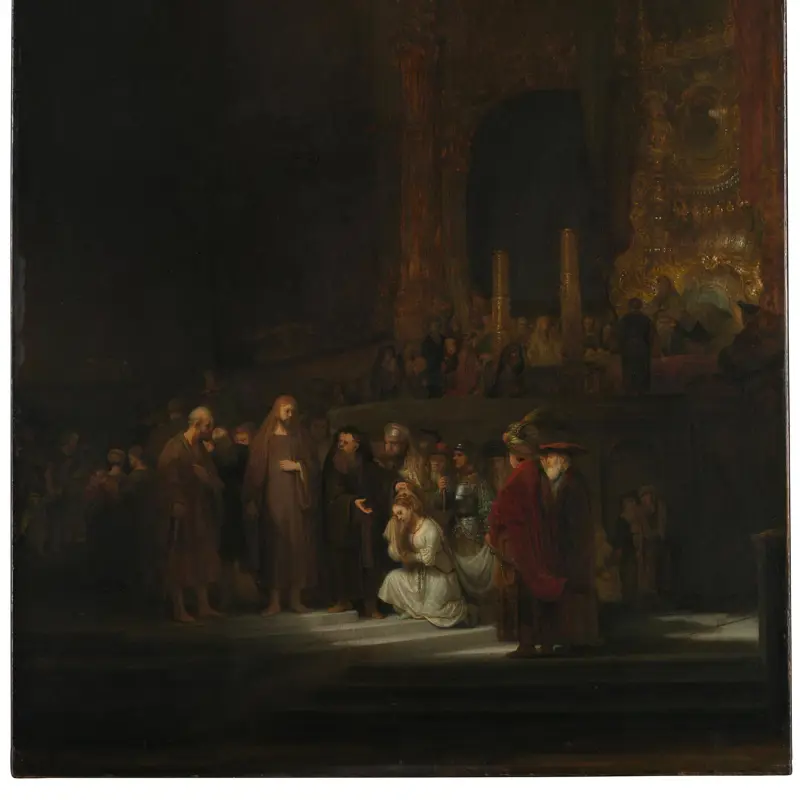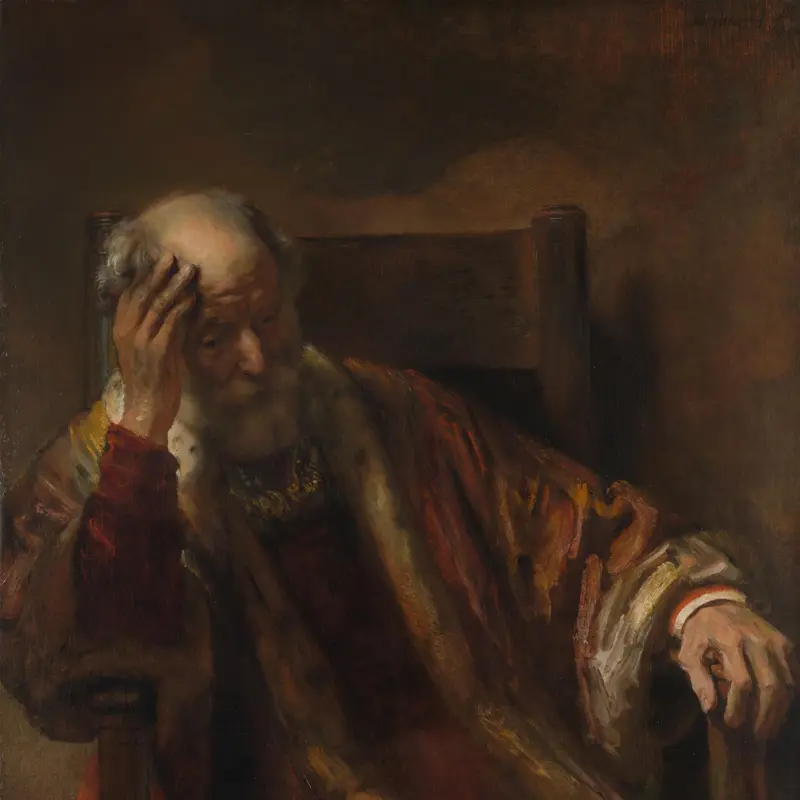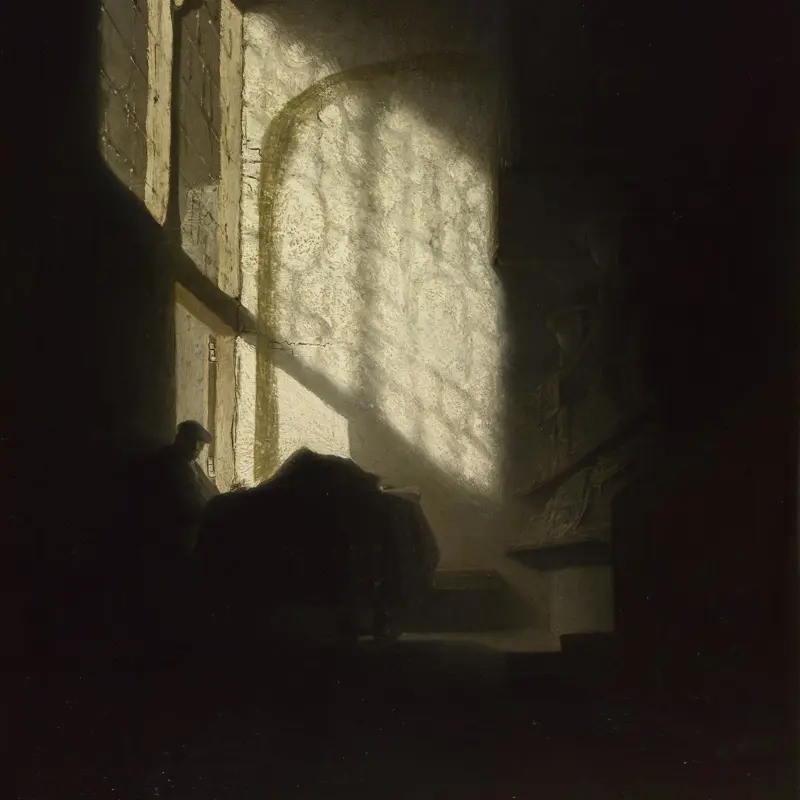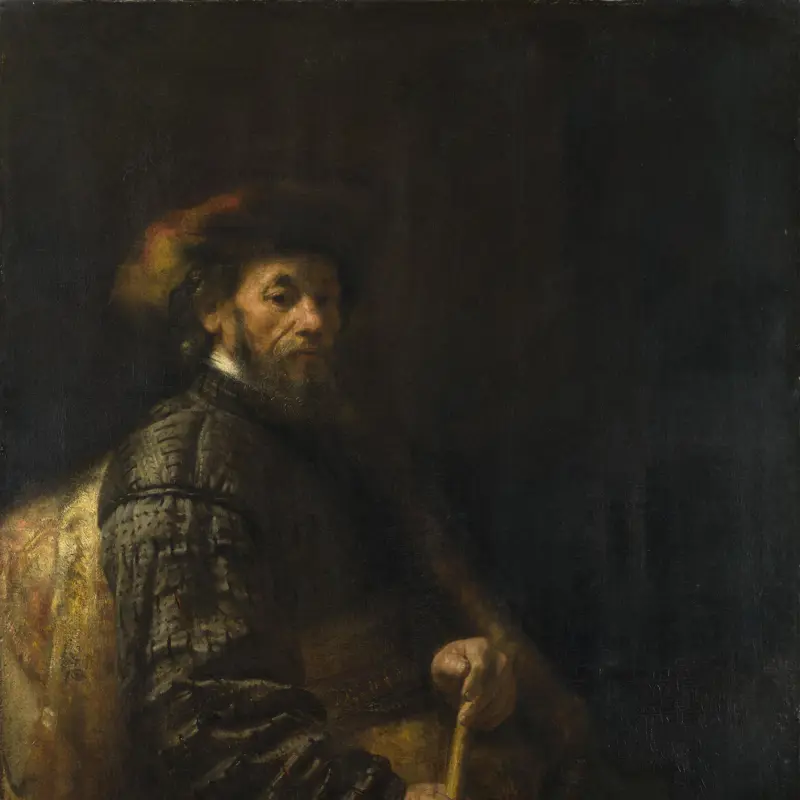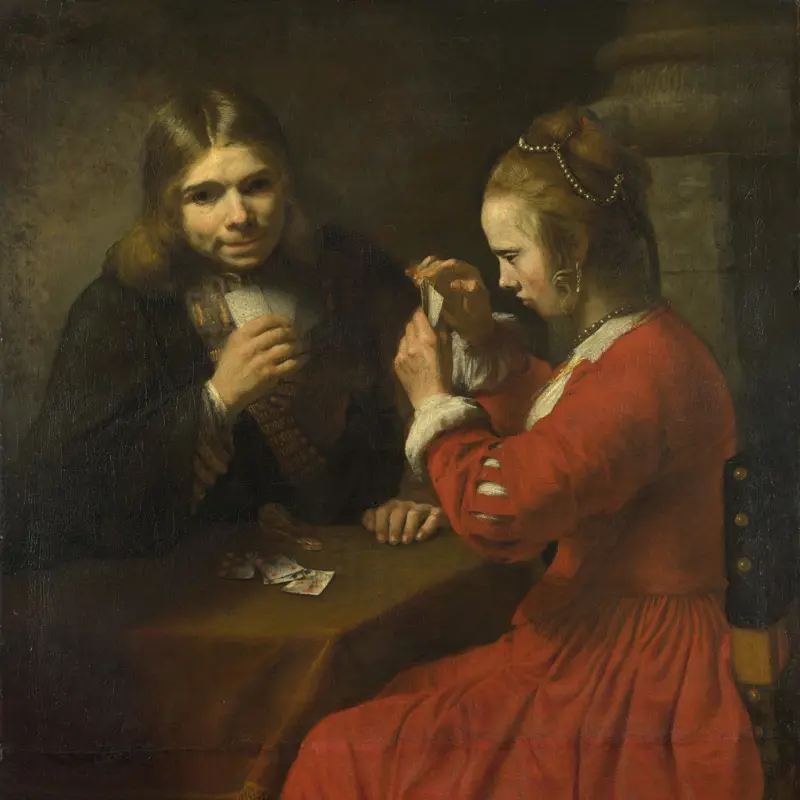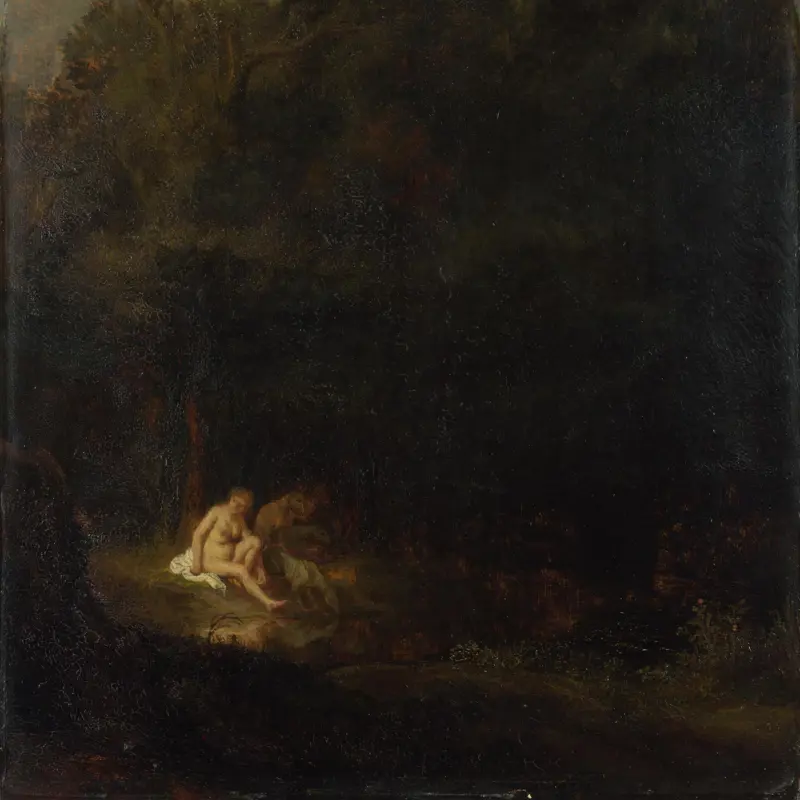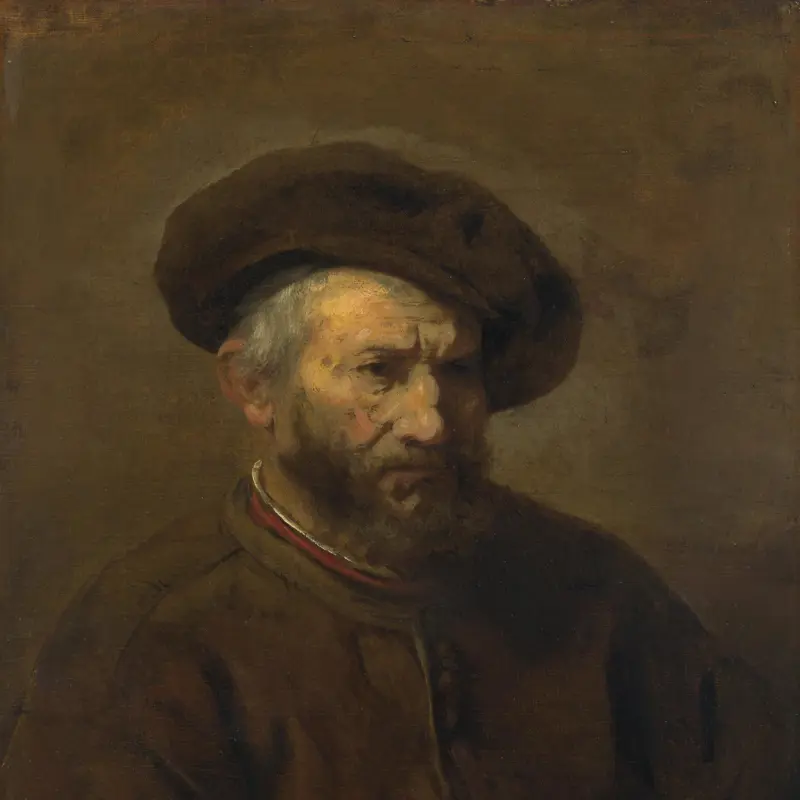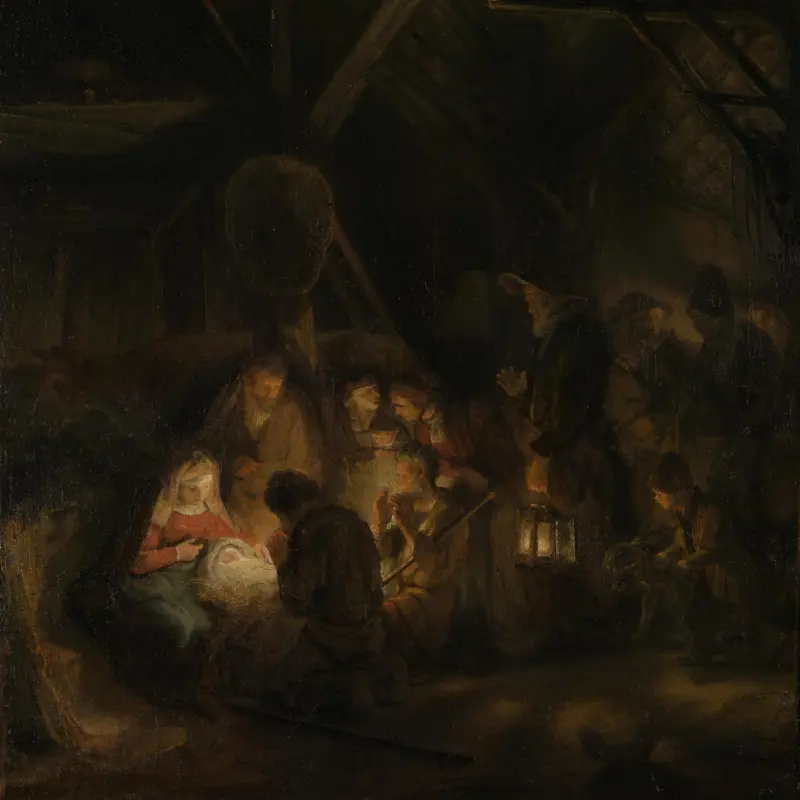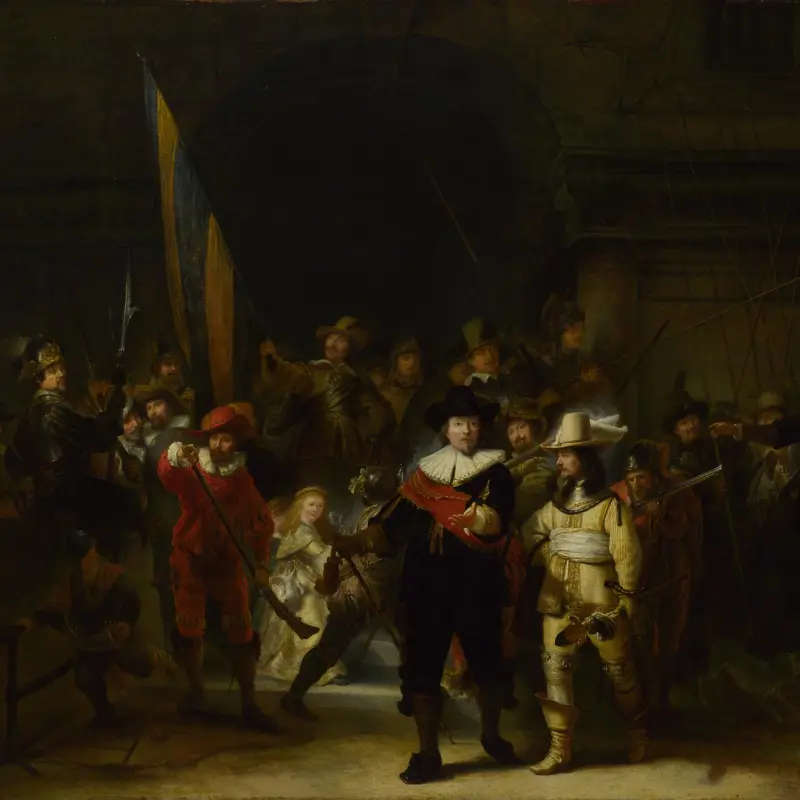Rembrandt, 'Self Portrait at the Age of 34', 1640
About the work
Overview
This is one of dozens of self portraits by Rembrandt. We see the artist in confident pose – self-assured, dressed in expensive-looking fur and velvet, his hat laced with jewels. But, though he is a Dutchman living in the 1640s, Rembrandt is wearing the clothes of a gentleman of the 1520s and his pose is based on paintings by Dürer, Titian and Raphael from a similar date. So, as the subject of the painting, Rembrandt is portraying himself as a Renaissance gentleman, and as the artist he is both paying homage to and directly comparing himself with the most famous artists of that time.
The implications of this double echo would certainly have been understood by Rembrandt’s sophisticated clientele. By taking the pose and clothes of a gentleman he was claiming a much higher social status than was usually afforded to artists at the time. And by citing the works of three of the greatest Renaissance painters, he is implying that he is their equal.
Audio description
Listen to an audio description of Rembrandt's 'Self Portrait at the Age of 34'
Transcript
This is a description of Rembrandt’s Self Portrait at the Age of 34. It is oil on canvas and was painted in 1640. It is 90cm high and 75 wide. The work is presented in a gilt frame with a rounded arch at the top that encloses the painted figure. The Dutch master has depicted himself from the waist up, richly dressed and leaning on a stone ledge which runs along the bottom of the painting. His stocky body is turned to the right, but his head is angled towards us. His gaze is confident and direct. His left arm is hidden, but his right is placed firmly on the ledge, his elbow protruding towards us and his loosely clenched fist rests against his stomach. Rembrandt is clothed in velvet and fur and wears a shapely dark velvet hat with a flat top and a stiff, folded back brim. In this work, Rembrandt’s brushstrokes are smooth and meticulous. He predominantly uses brown, black and cream tones, creating a warm, atmospheric, and dimly lit painting. The source of light is defused through the painting, softly illuminating the artist from the right side of his face. His face is round and pale, with ruddy cheeks and wispy brown facial hair. He has a bulbus nose, intense dark grey eyes and red lips that are firmly pressed together. The Dutch artist pays careful attention to how the light illuminates his skin, showing us his imperfections and the early signs of aging. He created this self-portrait in Amsterdam, at a successful point in his career, when he was considered the go-to portraitist in The Netherlands. This work reflects his high status not only through his self-
assured, confident pose – which suggests that he is leaning towards us - but also through his choice of clothes. The folded back brim of his black velvet hat reveals fine embroidery detailing and decorative jewels. His tawny jacket appears heavy and expensive: it is trimmed with brown fur at the collar and has voluminous black velvet sleeves that finish at the elbow. Underneath this he wears a brown tunic and a white shirt with finely embroidered trim at the neckline. This style was no longer in fashion by the 1640s. Rembrandt has purposefully presented himself in fancy renaissance costume, a style prevalent more than a hundred years earlier. This is not the only reference to the past he has used. With this painting, Rembrandt is likening himself to famous artists of the past who painted similar self-portraits. One striking comparison is to a portrait painted 125 years earlier by Titian, one of the greatest Italian painters of the 16th century. Rembrandt had most likely seen his work, or possibly a close copy of it, in a private collection in Amsterdam. He has borrowed several elements for his own painting. He copied the composition with the arm on the ledge, and the sleeves of their garments are similar. Both are big and dramatic and both portraits ended up at the National Gallery in London, which is a wonderful coincidence. Although there are similarities, there are also important differences between the works. Titian’s garments are a shiny, pastel blue silk and the man in the portrait is well-lit. Rembrandt on the other hand, chose
brown tones and a softer light – adding depth to his image. Rembrandt made many studies and portraits of himself throughout his career, in etchings, drawings and paintings. He used his self-portraits to publicly establish his image as a successful artist and a recognisable figure, solidifying his reputation during his lifetime, and after his death. This self-portrait is considered a high point in his style of work. In choosing this pose and the 16th-century dress, Rembrandt was aligning himself to the past and its famous artists. His appearance in this painting has often been described as confident, and some have even called it arrogant. Others have praised its qualities of complete calmness. With this impressive painting, Rembrandt actively places himself in an artistic tradition of “the greats”, and that might just summarise the vibe of this self-portrait: we are in the presence of one of the greats... and boy, does he know it.
Key facts
Details
- Full title
- Self Portrait at the Age of 34
- Artist
- Rembrandt
- Artist dates
- 1606 - 1669
- Date made
- 1640
- Medium and support
- Oil on canvas
- Dimensions
- 91 × 75 cm
- Inscription summary
- Signed; Dated and inscribed
- Acquisition credit
- Bought, 1861
- Inventory number
- NG672
- Location
- Room 15
- Collection
- Main Collection
- Frame
- 18th-century French Frame
Provenance
Sale of pictures belonging to Monsieur Perin, Paris, 4–5 March 1816, lot 37 (unsold); in the collection of General Dupont, Paris; exhibited at the Exposition de la Société des Amis de l’Enfance, Paris, 1861, lent by General Dupont’s heirs, Comte de Richemont, Vicomte de Richemont and Baron de Richemont, from whom purchased in September 1861.
Additional information
Text extracted from the ‘Provenance’ section of the catalogue entry in Neil MacLaren, revised and expanded by Christopher Brown, ‘National Gallery Catalogues: The Dutch School: 1600–1900’, London 1991 and supplemented by Bart Cornelis; for further information see the full catalogue entry
Exhibition history
-
2014Rembrandt and the Dutch Golden AgeSzépművészeti Múzeum28 October 2014 - 15 February 2015
-
2017Rubens and RembrandtThe National Gallery (London)22 March 2017 - 6 August 2017
-
2017Loan to the Norton Simon Art FoundationNorton Simon Art Foundation7 December 2017 - 5 March 2018
-
2020Masterpieces from the National Gallery, LondonThe National Museum of Western Art18 June 2020 - 18 October 2020The National Museum of Art3 November 2020 - 31 January 2021
-
2021Botticelli to Van Gogh: Masterpieces from the National Gallery, LondonNational Gallery of Australia5 March 2021 - 14 June 2021
-
2024National TreasuresBrighton Museum & Art Gallery10 May 2024 - 4 August 2024
Bibliography
-
1893É. Michel, Rembrandt, sa vie, son oeuvre et son temps, Paris 1893
-
1897W. von Bode and C. Hofstede de Groot, The Complete Work of Rembrandt, 8 vols, Paris 1897
-
1905C. Phillips, 'The "Ariosto" of Titian', Art Journal, LXVII, 1905, pp. 1-10
-
1907C. Hofstede de Groot, Catalogue Raisonné of the Works of the Most Eminent Dutch Painters of the Seventeenth Century, 10 vols, London 1907
-
1907C. Hofstede de Groot, Catalogue Raisonné of the Works of the Most Eminent Dutch Painters of the Seventeenth Century, 10 vols, London 1907
-
1946E.M. Bloch, 'Rembrandt and the Lopez Collection', Gazette des beaux-arts, XXIX, 1946, pp. 175-86
-
1960Maclaren, Neil, National Gallery Catalogues: The Dutch School, 2 vols, London 1960
-
1966K. Clark, Rembrandt and the Italian Renaissance, London 1966
-
1969E. de Jongh, 'The Spur of Wit. Rembrandt's Response to the Italian Challenge', Delta: A Review of Arts, Life and Thought in the Netherlands, 1969, pp. 49-67
-
1973A. Blankert, 'Rembrandt, Zeuxis and Ideal Beauty', in Album amicorum J. G. van Gelder, The Hague 1973
-
1980C. Brown, Titian: Portrait of a Man and Rembrandt: Self-Portrait at the Age of 34 (exh. cat. The National Gallery, 8 October - 7 December 1980), London 1980
-
1980R.B. Kitaj, The Artist's Eye: An Exhibition Selected by R.B. Kitaj at the National Gallery London, Lonodn 1980
-
1985G. Schwartz, Rembrandt: His Life, His Paintings, Harmondsworth 1985
-
1988D.R. Smith, '"I Janus": Privacy and the Gentlemanly Ideal in Rembrandt's Portraits of Jan Six', Art History, XI/1, 1988, pp. 42-63
-
1988D. Bomford et al., Rembrandt (exh. cat. The National Gallery, 12 October 1988 - 17 January 1989), London 1988
-
1989J. Mills and R. White, 'Paint Media Analyses', National Gallery Technical Bulletin, XIII, 1989, pp. 69-71
-
1991Maclaren, Neil, revised by Christopher Brown, National Gallery Catalogues: The Dutch School, 1600-1900, 2nd edn (revised and expanded), 2 vols, London 1991
-
1991C. Brown, J. Kelch and P.J.J. van Thiel, Rembrandt: The Master and his Workshop (exh. cat. Gemäldegalerie SMPK at the Altes Museum, 12 September - 10 November 1991; Rijksmuseum, 4 December - 1 March 1992; The National Gallery, London, 25 March - 24 May 1992), New Haven 1991
-
1992W. Liedtke, 'Rembrandt and the Rembrandt Style', Apollo, 1992, pp. 140-5
-
1993C. Tümpel, Rembrandt: All Paintings in Colour, Antwerp 1993
-
1995V.I. Stoichita, Efectul Don Quijote. Repere pentru o hermeneutica a imaginarului european, Bucharest 1995
-
1997A. Blankert, Rembrandt: A Genius and his Impact (exh. cat. National Gallery of Victoria, 1 October - 7 December 1997; National Gallery of Australia, 17 December 1997 - 15 February 1998), Melbourne 1997
-
2001
C. Baker and T. Henry, The National Gallery: Complete Illustrated Catalogue, London 2001
-
2017National Gallery, The National Gallery: Review of the Year, April 2016 - March 2017, London 2017
Frame
This is a French Louis XIV frame, crafted from oak. It probably dates to the beginning of the French Regency period, as suggested by the corner palmettes, centred shell motifs and the ‘décor mosaique en croisillons’ – a latticework taking the form of square mosaic shapes in a grid-like pattern, encased with crossing stripes or bars.
On the back edge of the frame is a cabochon (egg-and-nest) motif. Between the corner and the centre decorations, fleur-de-lis, scrolling leaves, flowers and tendrils adorn the frame, followed by a sanded flat. The sight moulding is adorned with ornamentation, including C-scrolls and centred flowers, influenced by the designer Jean Berain.
The frame has been restored and heavily overgilded, which has clogged the detailed carved recutting lines for which French craftsmen are renowned. The frame has been slightly enlarged in the corners, probably to cover gaps that appeared due to the shrinkage of the wood. To accommodate the shaped corners on Rembrandt’s Self Portrait at the Age of 34, the frame required an arched opening, which was created by spandrels, textured with sand and gilded.
About this record
If you know more about this work or have spotted an error, please contact us. Please note that exhibition histories are listed from 2009 onwards. Bibliographies may not be complete; more comprehensive information is available in the National Gallery Library.

